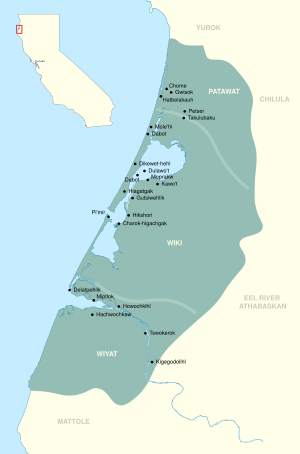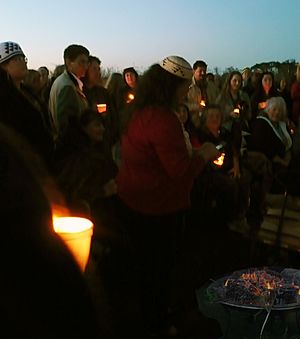Wiyot facts for kids

Map of Wiyot villages and dialects
|
|
| Total population | |
|---|---|
| 450 | |
| Regions with significant populations | |
| Languages | |
| English, historical Wiyot | |
| Related ethnic groups | |
| Yurok |
The Wiyot people are an Native American group from California. They live near Humboldt Bay and the surrounding areas. The Wiyot are similar in culture to the Yurok people. They called themselves Ku'wil, which means "the People."
Today, about 450 Wiyot people are alive. They belong to several federally recognized tribes. These include the Wiyot Tribe (also known as the Table Bluff Reservation—Wiyot Tribe), the Bear River Band of the Rohnerville Rancheria, Blue Lake Rancheria, and the Cher-Ae Heights Indian Community of the Trinidad Rancheria.
Contents
Wiyot History and Homeland
The Wiyot and Yurok people are the westernmost groups who speak an Algic language. Their languages, Wiyot and Yurok, are distantly related to the Algonquian languages.
The Wiyot people's traditional homeland stretched from the Mad River to Humboldt Bay. It also included the lower Eel River area. Inland, their land had many ancient redwood forests. The coastal areas were mostly sandy dunes and marshland.
The Wiyot people recognized three main groups based on their dialect and where they lived:
- The Patawat Wiyot or Mad River Wiyot lived near the Mad River.
- The Wiki Wiyot or Humboldt Bay Wiyot lived around Humboldt Bay.
- The Wiyat Wiyot or Eel River Wiyot lived near the Eel River delta.
The Wiyot were among the last Native Americans in California to meet white settlers. Spanish missions did not reach their area. Russian fur traders visited briefly in 1806 but were not interested in the region.
The Wiyot way of life changed greatly when Europeans began to settle. The Josiah Gregg exploring party visited Humboldt Bay in 1849-1850. Soon after, ships arrived to settle the bay. In 1850, Douglass Ottinger's crew were the first Americans to enter Humboldt Bay. White settlement quickly followed.
Fort Humboldt was built in 1853 by the Army. It was meant to be a buffer between Native Americans, gold-seekers, and settlers. Relationships between the Native Americans and newcomers became difficult. There were raids and acts of vigilante justice.
The 1860 Wiyot Massacre

On February 26, 1860, the Wiyot people suffered a terrible massacre. This event greatly reduced their numbers. It has remained a very important part of their history and identity.
Three days before the massacre, a man named Robert Gunther bought land on Indian Island. The day before the massacre, a local newspaper wrote that "Indians are still killing stock." It suggested they should be "driven from that section, or exterminated." Some local residents had already formed a secret group to deal with this problem.
For several days before the massacre, the Wiyot were holding World Renewal ceremonies. These ceremonies took place at the village of Tuluwat on Indian Island. This island is less than a mile from Eureka in Humboldt Bay. Up to 250 Wiyot people took part in the ceremonies. The leader of the Humboldt Bay Wiyots, Captain Jim, organized this important event to start a new year.
A group of white men came to the island early in the morning. This was after the last ceremony had finished. Most of the Wiyot men had left the island. Only women and children remained. The attackers used hatchets, clubs, and knives. They left their guns behind to avoid gunshots. Two other Wiyot villages were also attacked that night. These were on the Eel River and the South Spit.
Reports say that between 80 and 200 Wiyot people were killed that night. Most of them were women and children. There was only one survivor from the Tuluwat village massacre: an infant named Jerry James.
Robert Gunther, who lived nearby, was shocked by what he saw the next morning. He wanted to bring the attackers to justice. However, he soon learned that he "had better keep [his] mouth shut."
Three other attacks on Native American settlements happened within two days. These were at the South Spit (Eureka), South Fork Eel River (Rohnerville), and Eagle Prairie (Rio Dell). Gunther said that it was never publicly known who did the killing, but people secretly knew who the attackers were.
The 1860 massacre was well documented. A young writer named Bret Harte reported on it in San Francisco and New York City. Harte was working at a local newspaper at the time. He published a detailed report condemning the event.
Major Gabriel J. Rains, commander of Fort Humboldt, also reported on the massacre. He said that a group of vigilantes had decided to kill "every peaceable Indian – man, woman, and child." He reported that 55 people were killed at Indian Island, 40 on South Fork Eel River, and 35 at Eagle Prairie.
The local newspaper, The Humboldt Times, seemed to agree with the attacks. It wrote that the two races could not live together. It said that "either the pale face or the savage must yield the ground."
An investigation failed to find any attackers. No one was charged, even though many people knew who was responsible. Bret Harte was threatened and left the area. He wrote an anonymous letter describing how the community approved of the massacre.
The Wiyot people were greatly reduced in number. Survivors were taken to Fort Humboldt for protection. Many were later moved to the Round Valley Indian reservation. However, they often escaped and tried to return to their homeland.
Wiyot Population Decline
In 1850, about 2,000 Wiyot and Karuk people lived in this area. After the 1860 massacre, only about 200 Wiyot people were left. By 1910, fewer than 100 full-blood Wiyot people lived in their traditional lands. This quick population drop happened because of disease, slavery, and massacres. People were also forced to move from place to place, which survivors called "death marches."
Since 1992, memorials have been held every year at Tuluwat village on Indian Island. A large project to restore the culture and environment is happening there. Recently, the important World Renewal Ceremony has returned to the island. Current tribal members are working to bring it back fully. This event is private and very important to Wiyot cultural beliefs.
Table Bluff Reservation
In 2000, the Wiyot people established the Table Bluff Reservation. It is on 88 acres (360,000 m²) of their homeland. The reservation is 16 miles (26 km) south of Eureka. It is located between Loleta and the South Jetty of Humboldt Bay. About 350 people are part of the Table Bluff Reservation – Wiyot Tribe.
Since October 2019, the Wiyot have owned most of Indian Island. The City of Eureka previously owned this land.
Wiyot Culture and Beliefs
The last native speaker of the Wiyot language died in 1962. The Wiyot tribal government is now working to bring their language back to life.
A very important part of Wiyot spirituality is the annual World Renewal Ceremony. This ceremony is held at Tuluwat village. Indian Island, also called Duluwat Island, was and still is the center of the Wiyot world.
At the start of each year, the World Renewal ceremony took place on the island. This ceremonial dance lasted seven to ten days. People wore special masks during the dance. Everyone was welcome to attend. The ceremony was held at the Tuluwat village site on the northern part of the island. Traditionally, the men would leave the island and return the next day with supplies. The elders, women, and children would stay on the island to rest.
The Wiyot people mostly ate clams and acorns. They made long, carved canoes from logs. Healers and ceremonial leaders were often women. They received their powers on mountaintops during the night.
Wiyot Population Today
Alfred L. Kroeber estimated that about 1,000 Wiyot people lived in 1770. Sherburne F. Cook later estimated the population to be around 1,500, and then raised it to 3,300. Kroeber reported that the Wiyot population was 100 in 1910.
The Wiyot people faced terrible violence from American settlers in the 1850s and 1860s. This wiped out most of the population that was alive in 1850. It also took away their lands. The Wiyot who survived married into neighboring groups, like the Yurok. Today, about 500 Wiyot people live in Northern California. This number is still much lower than their population in the mid-1800s.
Recent Events and Restoration
In a step towards making things right, the Eureka City Council returned 40 acres (160,000 m²) of Indian Island to the Wiyot tribe in June 2004. The Wiyot already owned 1.5 acres (6,100 m²). The council also transferred 60 acres (240,000 m²) on the northeast tip of the island in May 2006.
Tuluwat, the sacred Wiyot village on Indian Island, is currently being restored by the Wiyot tribe. Businesses in Eureka have donated supplies and barges for trash removal. The people of Eureka have also donated money to a Tuluwat restoration fund.
In 2013, Wiyot tribe members returned to Indian Island by canoe. They announced plans to hold another World Renewal Ceremony. This would be the first such ceremony on the island since the massacre.
See also
 In Spanish: Wiyot para niños
In Spanish: Wiyot para niños

